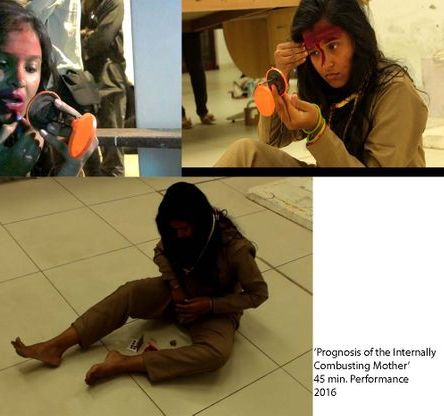Prognosis of the Internally Combusting Mother
As a student of SNU, I was part of the Kochi student’s biennale. We did a performance titled ‘Prognosis of the Internally Combusting Mother’. Though this was a group performance we had all devised our own acts in conjunction with each other. My part within this can also be a standalone performance.
For this I was dressed in a specially tailored one piece body suit. During the performance which lasted about 45 minutes, I repeatedly pulled out various objects like accessories and cosmetics seemingly from my Vagina. This was actually a bag like compartment stitched onto the inside of the suit. I was in a way referring to and re-contextualising Carolee Schneemann’s 1975 performance ‘The Interior Scroll’. By the end of the performance the cosmetics meant to ‘enhance’ a woman’s beauty covered my face like a grotesque war paint.
The major themes of my work till now have dealt with gender discrimination, the gaze, and voyeurism. This visual enquiry led me to the questions of enforced conformity, where I find myself framed within a certain socio-cultural, gendered, biased stereotypical slot. This also made me realize- the association of this gender based imaging within national iconographies, which are unofficial, mythical but have still been changing as per the national and impacting the polity.
These images propagate, and disseminate certain political agendas. How these images travel in people’s daily life, influence not only their responses but also their thought processes is what interests me. The framing of a discourse around a gendered image and its political association can be significantly observed in the recent past with respect to the image of Bharatmata.
It was surprising but interesting to see how the image of Bharatmata evolved in the general Indian psyche as per its political connotations. Then I started to find about what is this image of Bharatmata? Who made this? How did it transform to look like Durga? Why only a Mata (mother) and could it have be Pita (father)?
How did Bangamata become Bharat-Mata? Didn’t the geographical association of imagery impact its changed association with nationalism? Didn’t the transformation of a sadhvi to Durga, indicate its religious inclinations?
Can this reframed image of Bharatmata give justice to every citizen, irrespective of her/his class, caste and gender?
As Partha Chatterjee points out in ‘The Nation And its Women’, the nationalist ideology is predicated upon:
- Fixing of masculine/feminine qualities and accordingly demarcating watertight boundaries around home and the world; material and spiritual spheres
- Propagating the idea of woman as goddess/mother (thereby erasing her sexuality in the outside world)
- Propagating the idea of woman as sign of nation
- Seeming absence of autonomous women’s movements
- Feminist struggles waged in the home (not much evidence in the archives)—letters, art, cultural artifacts, literature
- The nationalist discourse was about women; but women did not speak

Every Indian woman thus has a patriarchal notion of Indian-ness incised on her. Does she have freedom to change her own image? From childhood each time my parents and elders used to try to instil in me certain social values and codes of conduct of how I should sit or behave as an (Indian) girl/woman- these I challenged in behaviour as well as in my work.

‘The Machine of money’
48’X 50’,
Painting which has been removed from the Jahangir Art Gallery in 2012)
Fig.2
Project Details
-
Prognosis of the Internally Combusting Mother

